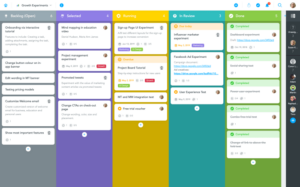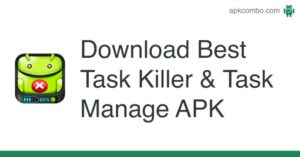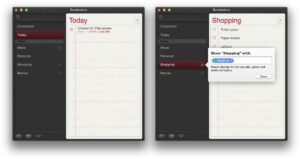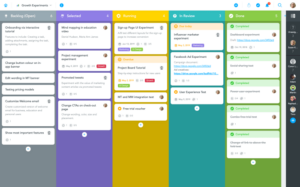Best Budgeting Apps to Make Managing Your Money: Uncover the world of financial freedom and control with our comprehensive guide to the top budgeting apps. Dive into the key features, user-friendly interfaces, and advanced tools that will revolutionize your money management.
In today’s fast-paced financial landscape, budgeting apps have become indispensable tools for individuals seeking to take charge of their finances. With a plethora of options available, choosing the right app can be a daunting task. This guide will provide you with all the information you need to make an informed decision and embark on a journey towards financial well-being.
Comprehensive Overview of Popular Budgeting Apps: Best Budgeting Apps To Make Managing Your Money
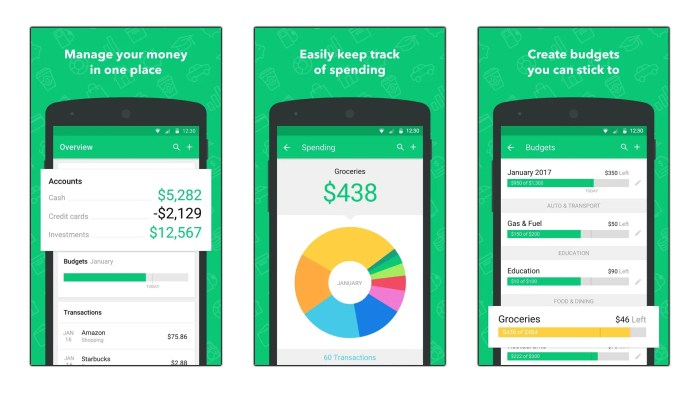
Budgeting apps have become increasingly popular as people seek ways to manage their finances more effectively. These apps offer a range of features to help users track expenses, create budgets, and plan for the future. In this section, we will provide a comprehensive overview of the most popular budgeting apps, comparing their features, costs, and compatibility.
The following table provides a side-by-side comparison of the key features, costs, and compatibility of different budgeting apps:
| Feature | Mint | YNAB | EveryDollar | Goodbudget | PocketGuard |
|---|---|---|---|---|---|
| Automatic Transaction Import | Yes | Yes | No | No | Yes |
| Budgeting Methods | Zero-based budgeting, envelope budgeting | Zero-based budgeting | Envelope budgeting | Envelope budgeting | Zero-based budgeting |
| Debt Management Tools | Yes | Yes | Yes | No | Yes |
| Investment Tracking | Yes | Yes | No | No | No |
| Mobile App | Yes | Yes | Yes | Yes | Yes |
| Cost | Free (with limited features), $169/year for premium | $119.99/year | Free, $12.99/month for premium | Free (with limited features), $7/month for premium | Free, $7.99/month for premium |
| Compatibility | iOS, Android, Web | iOS, Android, Web | iOS, Android, Web | iOS, Android, Web | iOS, Android, Web |
Strengths and Weaknesses of Each App, Best Budgeting Apps to Make Managing Your Money
Each budgeting app has its own strengths and weaknesses. Here is a brief overview of the advantages and disadvantages of each app:
- Mint:Mint is a popular budgeting app that offers a wide range of features, including automatic transaction import, budgeting tools, and investment tracking. It is also free to use, with a premium option available for additional features. However, Mint has been criticized for its privacy concerns and its lack of support for envelope budgeting.
- YNAB:YNAB is a zero-based budgeting app that helps users create a realistic budget and track their progress. It is known for its user-friendly interface and its focus on helping users get out of debt. However, YNAB is not free, and it may not be suitable for users who are not comfortable with zero-based budgeting.
- EveryDollar:EveryDollar is an envelope budgeting app that is based on the teachings of Dave Ramsey. It is a simple and easy-to-use app that is perfect for users who are new to budgeting. However, EveryDollar does not offer as many features as some of the other budgeting apps, and it is not available for free.
- Goodbudget:Goodbudget is another envelope budgeting app that is known for its simplicity and its focus on collaboration. It is a great option for couples or families who want to budget together. However, Goodbudget does not offer as many features as some of the other budgeting apps, and it is not available for free.
- PocketGuard:PocketGuard is a budgeting app that is known for its user-friendly interface and its focus on helping users save money. It offers a range of features, including automatic transaction import, budgeting tools, and debt management tools. However, PocketGuard is not free, and it may not be suitable for users who are not comfortable with zero-based budgeting.
User-Friendly Interface and Accessibility
The user-friendliness and accessibility of budgeting apps are crucial factors to consider. A well-designed interface makes it easy for users to navigate and manage their finances, regardless of their level of financial literacy.
The best budgeting apps offer intuitive navigation, clear menus, and visually appealing layouts. They often employ drag-and-drop functionality, swipe gestures, and color-coding to simplify data entry and categorization. The design should be clutter-free and responsive, adapting seamlessly to different screen sizes and devices.
Accessibility for All
Accessibility features are essential for users with disabilities or those who may struggle with traditional interfaces. These apps should provide options for larger fonts, high-contrast themes, and screen readers to ensure inclusivity. Voice-activated controls and tactile feedback can also enhance the user experience for individuals with visual impairments or dexterity issues.
Budgeting Tools and Features
Budgeting apps offer a comprehensive suite of tools and features to help users manage their money effectively. These include:
Expense Tracking
Expense tracking is a fundamental feature of budgeting apps. It allows users to record their spending across different categories, such as groceries, entertainment, and transportation. This data provides a clear picture of where their money is going, helping them identify areas where they can cut back.
Categorization
Categorization is essential for organizing expenses and tracking spending patterns. Budgeting apps allow users to assign each transaction to a specific category, making it easy to see how much they are spending in different areas. This information can help users identify areas where they may be overspending and make adjustments accordingly.
Financial Planning
Beyond expense tracking and categorization, budgeting apps offer tools for financial planning. This may include features such as:
- Goal setting:Set financial goals, such as saving for a down payment or retirement, and track progress towards achieving them.
- Budgeting:Create a budget based on income and expenses, and track actual spending against the budget.
- Debt management:Track debt balances and interest payments, and create a plan for paying down debt.
Customization
Budgeting apps offer a range of customization options to tailor the app to individual needs. These may include:
- Custom categories:Create custom categories to track specific expenses or income sources.
- Notifications:Set up notifications for upcoming bills, low balances, or overspending.
- Exporting data:Export financial data to a spreadsheet or other format for further analysis.
By leveraging these budgeting tools and features, users can gain a comprehensive understanding of their financial situation and make informed decisions about their spending and saving habits.
Integration and Compatibility
Integration and compatibility play a crucial role in the functionality of budgeting apps. Seamless integration with other financial tools, such as bank accounts, credit cards, and investment platforms, streamlines financial management and provides a comprehensive view of one’s financial situation.
Bank Account Integration
Budgeting apps that integrate with bank accounts allow for automatic transaction tracking and categorization. This eliminates the need for manual data entry, reducing the risk of errors and saving time. Real-time updates ensure that the budget is always up-to-date, reflecting the latest financial activity.
Credit Card Integration
Integration with credit cards provides insights into spending habits, debt management, and reward programs. Budgeting apps can track credit card transactions, alert users to potential overspending, and help them stay within their credit limits. Additionally, some apps offer features for managing multiple credit cards and optimizing rewards.
Investment Platform Integration
For investors, budgeting apps that integrate with investment platforms offer a consolidated view of their entire financial portfolio. Users can track investment performance, adjust asset allocation, and make informed financial decisions based on real-time data.
Cross-Device Compatibility
Compatibility with different devices and operating systems is essential for convenience and accessibility. Budgeting apps that are available on multiple platforms, such as smartphones, tablets, and desktops, allow users to manage their finances from anywhere, at any time. Cross-device syncing ensures that data is always up-to-date and accessible across all devices.
Best budgeting apps provide an easy and efficient way to manage your finances. They offer features such as expense tracking, budgeting, and financial planning. These apps can help you save money, make informed financial decisions, and achieve your financial goals.
In a similar vein, language learning apps have proven to be highly effective in helping individuals acquire new languages. By providing interactive lessons, personalized feedback, and immersive experiences, these apps make language learning accessible and engaging. The same principles of effective learning and financial management apply to both budgeting apps and language learning apps, making them valuable tools for personal growth and financial well-being.
Security and Data Protection
Budgeting apps prioritize the security and protection of users’ financial data. They employ robust measures to safeguard sensitive information, ensuring users’ peace of mind while managing their finances.
These apps utilize advanced encryption techniques to protect data during transmission and storage. They adhere to industry-standard protocols, such as AES-256 encryption, to ensure that data remains unreadable to unauthorized individuals.
Data Storage Practices
Budgeting apps employ secure data storage practices to protect user information. Data is typically stored on encrypted servers with limited access, ensuring its confidentiality. Regular backups and disaster recovery plans are in place to prevent data loss or corruption.
Privacy Policies
Budgeting apps have clear and transparent privacy policies that Artikel how they collect, use, and share user data. Users should carefully review these policies to understand how their information is handled. Reputable apps will not share or sell user data to third parties without explicit consent.
User Responsibilities
While budgeting apps implement robust security measures, users also play a crucial role in ensuring the security of their financial information. Here are some tips for users to enhance security:
- Use strong and unique passwords.
- Enable two-factor authentication (2FA) if available.
- Be cautious of phishing emails or messages requesting personal or financial information.
- Regularly review account activity for any unauthorized transactions.
- Contact the app’s support team immediately if you suspect any security breach.
Closing Summary
As you embark on your budgeting journey, remember that the best budgeting app is the one that aligns with your unique financial needs and preferences. By carefully considering the factors Artikeld in this guide, you can select the app that will empower you to achieve your financial goals, live within your means, and build a secure financial future.
Embrace the power of budgeting apps and unlock the path to financial freedom. Take control of your money today and experience the transformative impact of effective money management.

